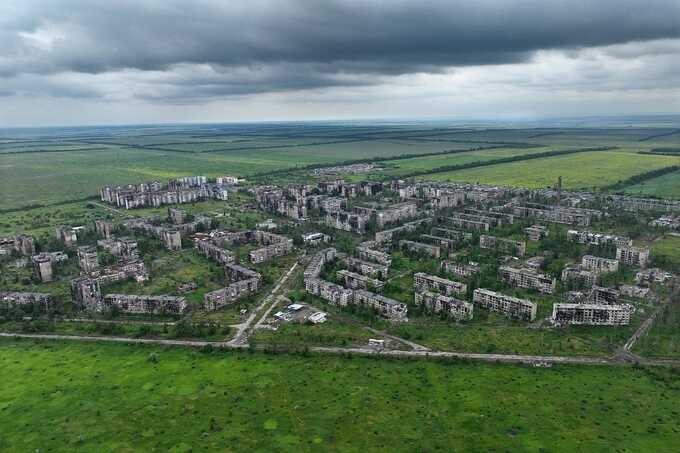Ukraine says its forces have withdrawn from defensive bastion of Vuhledar

Eastern city had resisted repeated attacks but Russian troops are close to ‘encircling’ it in Donetsk advance
Ukraine has said that its forces have withdrawn from the eastern city of Vuhledar, a defensive bastion that had resisted repeated Russian attacks since Vladimir Putin’s 2022 full-scale invasion.
The military command in Kyiv said its troops left late on Tuesday. They had retreated in order to preserve personnel and combat equipment, it said, adding that Russian combat units had attacked from three directions and were close to “encircling” the city.
The fall of Vuhledar is a boost for the Kremlin and comes as Russian troops advance across the eastern Donetsk oblast. In February they captured the city of Avdiivka, outside the regional capital of Donetsk, occupied in 2014.
Since then the Russian advance has swallowed up towns and villages and come to within six miles of the city of Pokrovsk, a logistics hub 80km (50 miles) north of Vuhledar. Defence experts think Ukraine may next have to retreat from other under-pressure urban settlements, including Toretsk and Selydove.
Russian Telegram channels published video of triumphant troops waving the Russian tricolour flag over shattered buildings in Vuhledar. In one clip, four soldiers stood inside a gutted highrise flat and placed a flag outside. “Everything will be Russia. Victory will be ours,” an officer declared.
The communist hammer and sickle was also raised. Vuhledar was originally built around a mine in the mid-1960s when it was within the Soviet Union. Before the war it had a population of about 14,000. It is now a sprawling ruin, with apartment buildings smashed apart and scarred.
Ukraine’s 72nd mechanised brigade had defended Vuhledar for more than two years. On Tuesday it said the Russians had suffered “numerous losses as a result of prolonged fighting” as it tried to storm the city, which sits on an elevated plain.
“In an effort to take control of the city at any cost, the enemy managed to direct reserves to carry out flanking attacks, which exhausted the defence of our units,” the brigade explained.
Russia claimed it had wiped out large numbers of fleeing Ukrainian soldiers. The Institute for the Study of War (ISW), however, said the scale of casualties was unknown and added that more would have been killed or captured if Russia had managed to encircle them.

An aerial view of Vuhledar, the site of heavy battles with Russian troops in the Donetsk region, 10 February 2023. Photograph: Libkos/AP
According to the ISW, the loss of Vuhledar will not fundamentally alter offensive operations because it is “not a particularly crucial logistics node”. Russian forces already controlled surrounding access roads, the institute said. They would now have to “manoeuvre” across open terrain in order to link up with units farther north.
The overall picture for Kyiv is grim. Russian forces are advancing in eastern Ukraine at their quickest rate for two years. A Ukrainian incursion in August into Russia’s Kursk region was launched to relieve pressure on its exhausted frontline troops. It prompted Moscow to divert some of its units – but these came from other parts of the battlefield, in the south and north-east.
Putin has said Russia’s chief political goal was to seize the whole of the Donbas region in south-eastern Ukraine. In September 2022, he claimed to have “annexed” four Ukrainian regions, including Donetsk and neighbouring Luhansk. Moscow controls just under a fifth of Ukraine as a whole, including about 80% of the Donbas.
The war has largely been a story of grinding artillery and drone strikes along a heavily fortified front stretching for nearly 1,000km (620 miles) and involving hundreds of thousands of soldiers. Russia has increasingly been employing pincer tactics to trap and then constrict Ukrainian strongholds.
Speaking in September, the Ukrainian president, Voldymyr Zelenskyy, acknowledged the situation in the east was difficult. He said the Russians were using airdropped guided bombs to “destroy everything”. They “finished off” with artillery and then sent in infantry to capture Ukrainian positions, he said.
Zelenskyy has repeatedly argued that Kyiv needs long-range weapons to counter the Kremlin’s superior air power. So far, however, he has been unable to persuade the US president, Joe Biden, to allow the use of US-provided weapons such as Atacms (army tactical missile systems) to destroy aerodromes and other military targets deep within Russia.
During a trip to Washington and New York last week – which included a meeting with Biden, as well as with the vice-president, Kamala Harris, and Donald Trump – Zelenskyy again called for restrictions to be lifted. The UK is supportive. But so far it has not managed to overcome White House fears of possible nuclear escalation with Russia.
In the US, Zelenskyy also outlined his vision for a “just peace”. His plan for ending the war featured economic assistance from the west and enhanced military support. Another element appears to involve a possible trade of territory controlled by Ukraine inside Russia’s Kursk province for Ukrainian land occupied by Russia.
After gaining Vuhledar, Russian bloggers said Russia could now try to push towards Velyka Novosilka, just over 30 km (20 miles) to the west in the neighbouring Zaporizhzhia province. Vuhledar sits close to a railway line going to Crimea, which Moscow seized in 2014. Russian forces currently control 98.5% of the Luhansk region and 60% of the Donetsk region.

Vuhledar, pictured here 25 February 2023, is ‘not a particularly crucial logistics node’, said the ISW, though it lies close to a railway line going to Crimea. Photograph: Evgeniy Maloletka/AP
Read more similar news:
Comments:
comments powered by Disqus

































